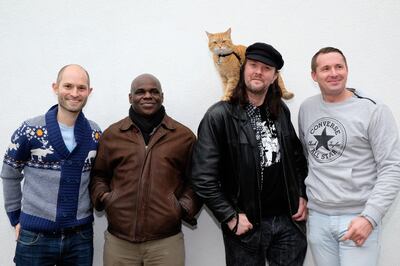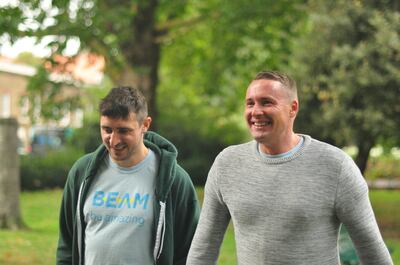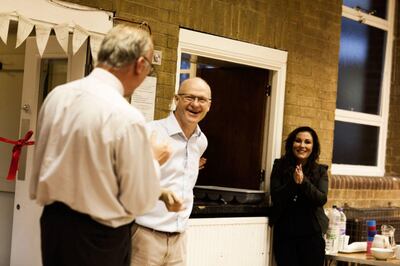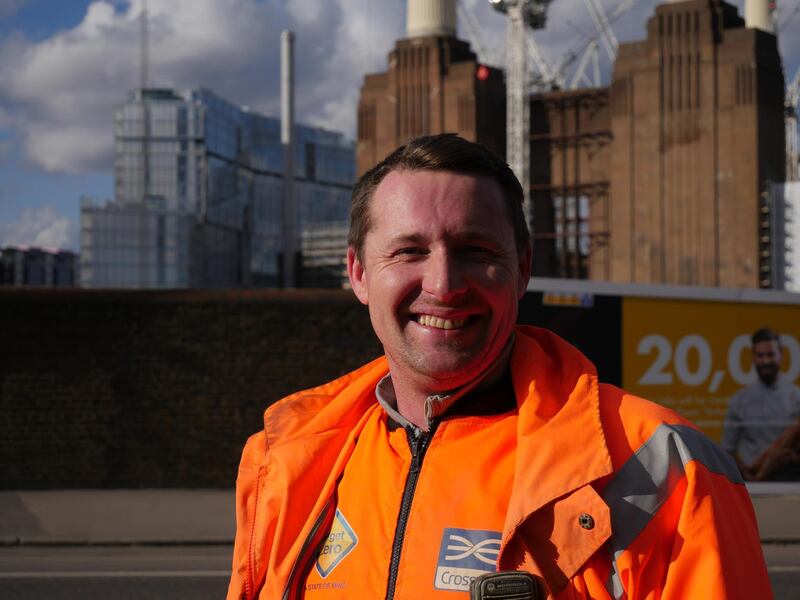The role of slinger-signaller on a building site is a specialist job that can make a difference between life and death.
Tasked with making hand signals that direct crane and equipment operators, the job requires training and reliability.
For one particular worker on the new extension to London's underground Northern line, Joe, the new job is a vindication of his battle to overcome the deprivations of homelessness. It is also the product of a new wave of entrepreneurs bringing capital and technology to assist the growing army of dispossessed.
Joe has gone through a lot to get a slinger-signaller job. Having struggled with addiction, he was homeless for over a decade before undergoing treatment in 2017. After recovering, he was helped back into work by a pioneering new scheme using crowdfunding to deliver skills training to get back into full-time employment.
Homelessness has soared in Britain over the past decade and currently there are more than 300,000 people recorded as living without permanent accommodation. In England in 2017 an estimated 4,751 people were rough sleeping - up 15 per cent on the previous year.
Under pressure to address the problem, the British government has pledged to halve the number of rough sleepers by 2022 and eradicate rough sleeping altogether by 2027 using a £30 million (Dh156m) fund given to local councils.
However, the government drive to end rough sleeping only addresses a small part of a complex issue. Spurred by the highly visible suffering, especially in the capital where nearly a quarter of rough sleepers in England are based, London residents, including tech entrepreneur Alex Stephany are responding with their own ideas.
Troubled by seeing more and more people on the streets, Mr Stephany, the former CEO of parking app JustPark, last year started his own charity called Beam, a crowdfunding platform to help homeless people train up and get back into work.

Having previously used equity crowdfunding during his tenure at the head of a tech start-up to raise Dh22.7m from 2,700 people, the 36-year-old began to think about how he could use his skills to benefit those most in need.
“I thought 'wow this is a really powerful model. Can we use crowdfunding to help some of the most vulnerable people in society as well?'” Mr Stephany tells The National.
It was after having a conversation with a homeless man at his local tube station that the idea for Beam came about.
“We were talking about his ambitions. He’d spent a very long time out of work and I just had a really simple thought: I’ve seen this person is a nice individual with a lot to contribute and I thought what can I do now? I can buy them a coffee or give them some cash but for me that wasn’t enough.
“I asked myself, 'how can I make a really smart positive investment in this person’s future that will help this individual for the long-term and will help this individual’s children as well?'”
Having consulted with homelessness charities, he recognised that barriers to finding work were a major obstacle that kept people dependant on temporary accommodation, Mr Stephany created a model by which people could gain the skills they needed to get back into permanent and meaningful employment.
Beam works by identifying potential “members” - people who have been homeless - before talking with them about their career goals and putting together an exact budget for their training. Their online campaign is set up and they are crowdfunded for the amount they need for the training.
Joe was one of the first Beam members and has aspirations to become a better paid crane rigger one day. His online campaign raised £1,132 from 19 supporters in just five days and he was able to undertake his slinger signaller course within a matter of weeks, a qualification he passed with flying colours.

Joe tells The National he had struggled to find employment for a long time before his training: “There was nothing for me until Beam came along ... I was looking for work but it was looking bleak.”
Within three months of achieving his qualification, Joe is working for a large construction labour supplier, VGC Group. The crowd-funding experience has given him new opportunities as well as a confidence boost.
“It made me feel so much better,” he said. “I thought it would take months but within five days the money was there and I was ready for training. The fact that people out there are willing to give me their money to do training has made me want to prove myself even more. It was so uplifting.”
Beam is one of a growing number of organisations in the UK harnessing technology to help the homeless.
_______________
Read more:
[ UAE Helping Hands: Homeless Indian woman thanks readers for donations ]
[ How a cashless society is boosting the fortunes of London's homeless ]
_______________
Perhaps the most-well known example of this is StreetLink, a mobile phone app and website created by charity Homeless Link, which allows the public to send an alert when they see someone sleeping rough. With a description of where and when the individual was seen, an outreach team can locate them and connect them to the appropriate support services.
During the recent cold weather in the UK, social media users shared links to the StreetLink app as fears were raised about people freezing after being forced to sleep outside in the sub-zero temperatures. In the week commencing February 26, in which there was heavy snowfall, StreetLink received 35,000 alerts - the highest ever number in one week since its inception in 2012.
Of course, advancing technology is not the solution to a homelessness crisis primarily caused by the lack of affordable housing in Britain, according to Patrick Mulrenan, senior lecturer at London Metropolitan University.
“The main obvious cause of the rise in homelessness is cost of housing, which reflects the short supply of housing,” he tells The National. “The poor supply is because we haven’t built enough homes for the past 30 or 40 years.”
To start to address the issue of homelessness, a bigger supply of housing is needed, Mr Mulrenan says.
“In one way or another, we have to invest money in housing. At the moment it is done the wrong way and [the state has] invested in housing benefit, which comes to £24bn a year. That is a huge amount of money which is not productive money because it is going into hands of landlords and is not building any more homes.”
However, government solutions such as building more houses are years away from making a difference, so Mr Stephany believes technology and micro-credit support schemes have a role to play.
“Homelessness is a complex problem, which cannot be solved by simply throwing money at it. It requires significant amounts of innovation, technology and data,” he says.
Another supporter of this ethos is Martin Stone, who has been running the Muswell Hill soup kitchen in north London for the past 10 years, and recently began giving its visitors smartphones.

“Phones are the vital lifeblood of being on the street,” Mr Stone tells The National.
“Having a phone gives you half a chance. It allows you to keep in communication with- people that can help. It is just where we are in 2018.”
With free WiFi offered in many places around London, a smartphone is an essential piece of modern technology for homeless people and can even save lives.
Before giving a homeless person a phone, Mr Stone and his team of volunteers download apps on the device from the UK National Health Service, suicide awareness charities and Next Meal, an app which maps the opening hours of London’s soup kitchens.
Mr Stone, who also works as a housing lecturer, created Next Meal, a website and an app, with the help of a Silicon Valley tech expert last year.
“We created Next Meal because we did not want people begging on the street,” says Mr Stone, who got the idea while using an app at a bus stop.
“Begging is bad for anyone’s self-esteem and some people are begging because they are being controlled by gangs.”
A user can either download the app or go to the website, type in their location and a list of nearby shelters and the facilities they offer appears.
Anyone wishing to help a rough sleeper can do so by using Next Meal and pointing them to their nearest soup kitchen.
Or better still they can donate an old smartphone to Muswell Hill soup kitchen, which will be given to a homeless person who can download the app themselves.
“What the world needs is ideas that fit a certain situation for a certain time,” said Mr Stone, who hopes to roll Next Meal out through Europe.
“That’s what technology does. And when it doesn’t work, it dies instantly.”







